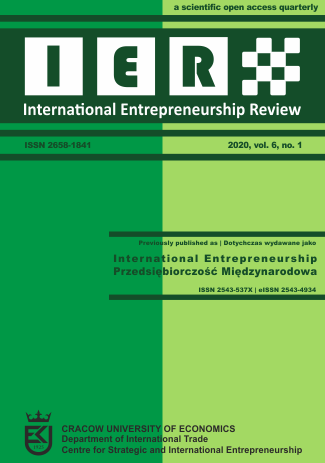Factories Europe, Asia, and North America as the main production centres in the 21st century

Abstract
Objective: The paper aims to present how the relations between countries in global value chains (GVC) changed at the beginning of the 21st century.
Research Design & Methods: For this purpose, we propose two approaches. The first focuses on presenting data in the form of a matrix of trade flows in domestic value added in intermediate products. The second is related to analyzing the GVC indicator (GVC participation).The analysis uses data from the OECD and WTO Trade in Value Added databases.
Findings: The global economy still is not unified. I indicate the existence of 3 major supply chain blocks, which can be called Factories: Factory Europe, Factory Asia, and Factory North America. In the trade of intermediate products, the primary relationships are inter-regional rather than intra-regional. Some countries act as hubs. Germany and the US play the role of regional supply hubs, while China assumes the role of the world supply hub, becoming the largest exporter and importer in GVC activities.
Contribution & Value Added: The use of export data in value-added terms instead of gross export data indicates significant differences in the description of world economy trade relations.
Keywords
global value chains (GVC), Factories, major supply chain blocks, gross exports, value-added exports, TiVA
Author Biography
Aleksandra Nacewska-Twardowska
Master of Economics (University of Lodz, Poland); PhD student in Economics (University of Lodz, Poland). Her research interests include international trade, global value chains and economic integration.
References
- Ambroziak, Ł. (2018a). Determinanty handlu zagranicznego Polski mierzonego wartością dodaną. International Entrepreneurship Review/Przedsiębiorczość Międzynarodowa, 4(1), 9-22. https://doi.org/10.15678/PM.2018.0401.01
- Ambroziak, Ł. (2018b). Wartość dodana w handlu zagranicznym nowych państw członkowskich unii Europejskiej. Oficyna Wydawnicza SGH.
- Baldwin, R. (2008). Managing the Noodle Bowl: The Fragility of East Asian Regionalism. The Sin-gapore Economic Review, 53(3), 449-478.https://doi.org/10.1142/S0217590808003063
- Baldwin, R., & Lopez-Gonzales J. (2015). Supply‐Chain Trade: A Portrait of Global Patterns and Several Testable Hypotheses.The World Economy, 38(11), 1682-1721.https://doi.org/10.1111/twec.12189
- Behar, A., & Freund, C. (2011). Factory Europe? Brainier but not Brawnier. FREIT Working Paper, No. 312.
- Folfas, P. (2016). Handel międzynarodowy mierzony wartością brutto oraz wartością dodaną – analiza porównawcza. Oficyna Wydawnicza SGH.
- Fritsch, M., & Matthes, J. (2020). On the global value chains and the intra-European division of labour. National Institute Economic Review, 252. https://doi.org/10.1017/nie.2020.16.
- Gereffi, G., Humphrey, J., Kaplinsky, R., & Sturgeon, T.J. (2001). The Value of Value Chains: Spreading the Gains from Globalisation. IDS Bulletin,32(3).
- Inomata, S. (2017). Analytical frameworks for global value chains: An overview. In Global Value Chain Development Report 2017: Measuring and analyzing the impact of GVCs on economic development (pp. 15-35). International Bank for Reconstruction and Development/The World Bank.
- Johnson, R.C., & Noguera, G. (2012). Proximity and Production Fragmentation.. American Econom-ic Review, 102 (3), 407-411. http://dx.doi.org/10.1257/aer.102.3.407
- Kordalska, A., & Olczyk M. (2019). Is Germany a Hub of ‘Factory Europe’ for CEE Countries? Ekonomista, 6, 734-759.
- Koopman, R., Powers, W., Wang, Z., & Wei, S.J. (2010). Give Credit Where Credit Is Due: Tracing Value Added in Global Production Chains. NBER Working Paper, 16426. DOI: 10.2139/ssrn.1949669
- Li, X., Meng, B., & Wang, Z. (2019). Recent patterns of global production and GVC participation. In Technical innovation, supply chain trade, and workers in a globalized world. Global Value Chain Development Report 2019 (pp. 9-44). World Trade Organization.
- Meng, B., Xiao, H., Ye, J., &Li, S. (2019). Are global value chains truly global? A new perspective based on the measure of trade in value added. IDE Discussion Papers, No. 736.
- Miroudot, S., & Nordstrom, H. (2019). Made in the World Revisited. EUI Working Paper RSCAS, 2019/84. http://dx.doi.org/10.2139/ssrn.3489137
- Organisation for Economic Co-operation and Development (2016). Trade in Value-Added and Global Value Chains profiles. Explanatory notes. http://www.oecd.org/industry/ind/ measur-ing trade in value-addedanoecd-wtojointinitiative.htm, access: 22.10.2016.
- Organisation for Economic Co-operation and Development (2019). Guide to OECD’s Trade in Value Added (TiVA) Indicators. 2018 edition. https://www.oecd.org/sti/ind/tiva/TiVA2018_Indicators_Guide.pdf, December 2019, access: 30.01.2020.
- Organisation for Economic Co-operation and Development (2020). Trade in Value Added (TiVA). https://stats.oecd.org/, access: 30.01.2020.
- Stehrer, R., Foster, N., & Vries, G. (2012). Value Added and Factors in Trade: A Comprehensive Approach. WIIW Working Paper, 80, The Vienna Institute for International Economic Studies.
- United Nations Conference on Trade and Development (2013). World Investment Report 2013: Global Value Chains: Investment and Trade for Development. United Nations.
- World Trade Organization (2014). World Trade Report 2014. Trade and development: recent trends and the role of the WTO. World Trade Organization.
